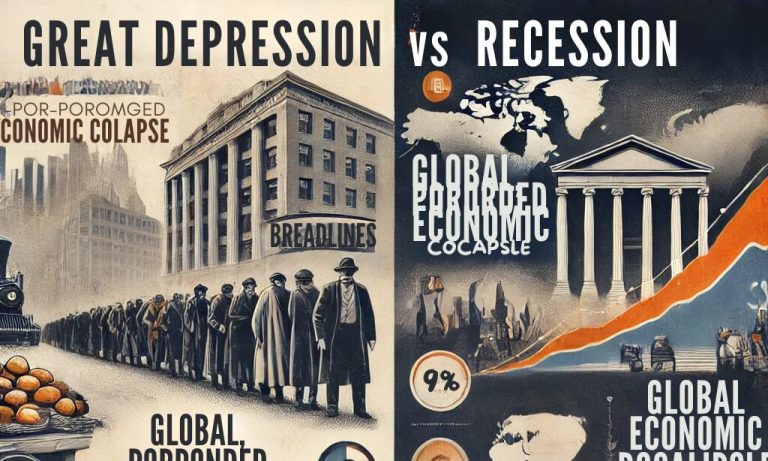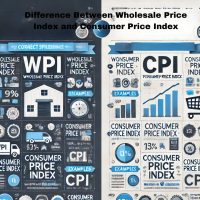The difference between Great Depression and Recession lies in their severity, duration, and economic impact. The Great Depression was a devastating and protracted collapse of the global economy from 1929 to the late 1930s. A recession, in contrast, is a short-term setback, typically for months or up to two years, measured by decreasing GDP and increasing unemployment. It helps to have an understanding of these differences to comprehend how economies behave in reaction to these kinds of disasters and better assess their long-term impact.
What is Great Depression?
The Great Depression was a catastrophic and prolonged collapse of global economies that started with the crash of the U.S. stock market in October 1929. It caused immense economic, social, and political disruption across the world not just for the duration but for generations. Economic policies and financial systems were affected in ways that have not been seen again in economic history.
Example: In the United States, industrial production dropped by 46%, and international trade shrank by over 50% during the Great Depression.
Causes of Great Depression
Several interconnected factors contributed to the Great Depression, making it a complex and devastating event.
- Stock Market Crash: The crash wiped out billions of dollars in wealth, leading to panic selling and a collapse of investor confidence.
- Banking Failures: Poor regulation and a lack of deposit insurance caused bank runs and the closure of thousands of banks, which restricted access to credit.
- Decline in Consumer Spending: As unemployment rose and incomes fell, consumer spending decreased, causing businesses to cut production and lay off workers.
- Protectionist Policies: The Smoot-Hawley Tariff Act of 1930 imposed high tariffs on imports, reducing international trade and exacerbating the economic downturn globally.
- Example: Global trade or International Trade volumes fell drastically as countries retaliated with their tariffs, deepening the economic crisis.
Impact of Great Depression
The Great Depression has a wide and long-term impact on the world economy, society, and governance.
- Economic Impact: Industrial output fell sharply, leading to widespread business closures. Global trade declined by over 50%, disrupting supply chains and markets.
- Social Impact: Millions of families became homeless, hungry, and extremely poor. Malnutrition and deplorable living conditions became rampant, especially in rural areas.
- Policy and Political Effect: Governments adopted reforms such as the U.S. New Deal to stabilize the economy and protect workers. Its banking system reforms gave birth to institutions such as the Federal Deposit Insurance Corporation (FDIC).
- For instance: Social Security and labor protections formed part of the New Deal, which basically transformed the intercourse between the citizens and the governments.
What is Recession?
A recession is a period of general temporary economic decline, usually defined as two successive quarters of negative GDP growth. Less severe than actual depressions, recessions can still cause significant financial hardship to families and businesses.
Example: The 2008 Global Financial Crisis triggered a recession that lasted 18 months and caused widespread job losses and business failures.
Causes of Recession
A recession is generally caused by a mix of economic, financial, and other factors.
- Economic Shocks: Sudden pandemics, like COVID-19, and even geopolitical conflicts might disrupt the stability of an economy.
- Tight Monetary Policy: The propagation of high interest rates to curb inflation would discourage borrowing and spending, thereby reducing economic growth.
- Market Bubbles: The bursting of speculative bubbles, such as the housing bubble in 2008, is a source of financial instability.
- Deterioration of Business Investment: Reduced business investment would lower production and employment, which would contribute to the economic contractionary effect.
Impact of Recession
Though less severe than depressions, recessions still cause notable disruptions in economic and social systems.
- Economic Impact: GDP and industrial production decline and Retail sales and consumer spending fall, affecting businesses.
- Social Impact: Unemployment rises, reducing household incomes and purchasing power. Families face financial strain, impacting their quality of life.
- Government Response: Central banks lower interest rates to encourage borrowing and investment. Governments implement stimulus packages, such as tax cuts and direct financial aid.
- Example: During the COVID-19 recession, governments worldwide launched stimulus programs to support businesses and individuals.
Key Differences Between Great Depression & Recession
The difference between Great Depression and Recession lies in their scale, causes, and overall impact on economies and societies. Below is a detailed comparison to help understand these distinctions better:
Severity of Economic Decline
- Great Depression: The Great Depression was an unprecedented global economic collapse that led to drastic reductions in GDP, industrial output, and trade. The extent of this economic decline was catastrophic, with GDP dropping by over 30% in some nations. Unemployment rates soared to more than 25% in countries like the U.S., leaving millions of people jobless and destitute. The banking system also collapsed, resulting in widespread financial instability.
- Recession: Recessions are less severe and characterized by smaller declines in GDP and industrial production. The effects of a recession are usually confined to specific sectors or regions, and unemployment typically remains below 15%. While recessions cause economic hardship, they are not as catastrophic or widespread as a depression.
Duration
- Great Depression: The Great Depression lasted over a decade, beginning in 1929 and extending into the early 1940s in some regions. Its prolonged duration allowed economic devastation to deepen, causing widespread poverty and social unrest. Recovery was slow and required large-scale interventions like the New Deal in the United States.
- Recession: Recessions are much shorter in comparison, typically lasting from six months to two years. The duration depends on the severity of the economic triggers and the effectiveness of government and central bank interventions.
Global vs. Local Impact
- Great Depression: The Great Depression had a truly global reach, affecting virtually every nation. Countries experienced sharp declines in trade and industrial output, as economies were heavily interconnected through trade routes and financial systems. The worldwide nature of the crisis led to widespread poverty, political instability, and economic reforms on a global scale.
- Recession: Recessions often have a more localized impact, primarily affecting specific countries or regions. While global recessions like the 2008 Financial Crisis can occur, their effects are generally less widespread than those of the Great Depression. Recessions may also vary in intensity across regions, depending on local economic conditions.
Unemployment Levels
- Great Depression: Unemployment rates during the Great Depression reached historic highs. In the United States, unemployment exceeded 25%, and in some regions, it went even higher. The lack of social safety nets and economic support exacerbated the hardships faced by individuals and families, leading to widespread homelessness and hunger.
- Recession: Recessions also result in increased unemployment, but the rates are generally much lower than those seen during a depression. Job losses are often temporary, as businesses recover when economic conditions improve.
Policy Responses
- Great Depression: Addressing the Great Depression required large-scale, long-term structural reforms. Governments introduced comprehensive policies to stabilize economies, regulate financial systems, and financial management, and provide social support. In the U.S., the New Deal introduced programs like Social Security, unemployment insurance, and labor protections, which fundamentally reshaped the economy and the role of government in society.
- Recession: Recessions are typically managed through short-term interventions, such as monetary and fiscal policies. Central banks lower interest rates to encourage borrowing and investment, while governments implement stimulus packages to boost consumer spending and business activity.
| Aspect | Great Depression | Recession |
| Severity | Global economic collapse with GDP drops over 30% and unemployment exceeding 25%. | Smaller GDP declines, sector-specific impacts, and unemployment usually below 15%. |
| Duration | Lasted over a decade (1929–1940s), with slow recovery and widespread devastation. | Typically lasts 6 months to 2 years, with faster recovery depending on interventions. |
| Impact | Worldwide effects, with sharp trade declines and interconnected economic collapses. | More localized, though global recessions (e.g., 2008) can occur; effects vary by region. |
| Unemployment | Historic highs (e.g., >25% in the U.S.), leading to homelessness and hunger. | Increased unemployment, but rates are lower and recovery is quicker. |
| Policy Response | Required large-scale structural reforms like the New Deal, with lasting economic and social changes. | Managed through short-term measures such as interest rate cuts and stimulus packages. |
Conclusion
The main difference is that a Great Depression should be far more vigorous and broader in scale compared with any recession. A Great Depression is unprecedented, extreme, and global in scope; recessions are generally milder, typically taking place within ordinary cycles of economic activity. Understanding these differences empowers policymakers to create targeted measures to stabilize economies, protect against downturns, and promote sustainable growth.
Great Depression vs Recession FAQs
What is the Great Depression?
The Great Depression was a worldwide economic downturn lasting from 1929 to around the late 1930s, characterized by widespread unemployment and economic collapse.
What is a recession?
A recession is a brief phenomenon that results in reducing economic activities for a duration of three months to two years, where gross domestic product declines and unemployment increases.
How long does a recession last?
Recession lasts for six months to two years
What led to the Great Depression?
Causes of the Great Depression include the stock market crash in 1929, banking failures, less consumer spending, and protectionist policies.
Can a recession morph into a depression?
Yes; if not checked or worsened by poor responses in policies, a recession can spin out of control into a depression.


